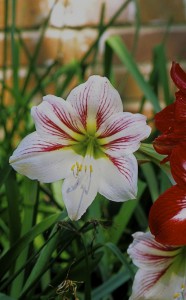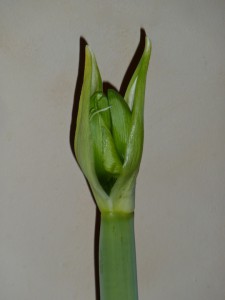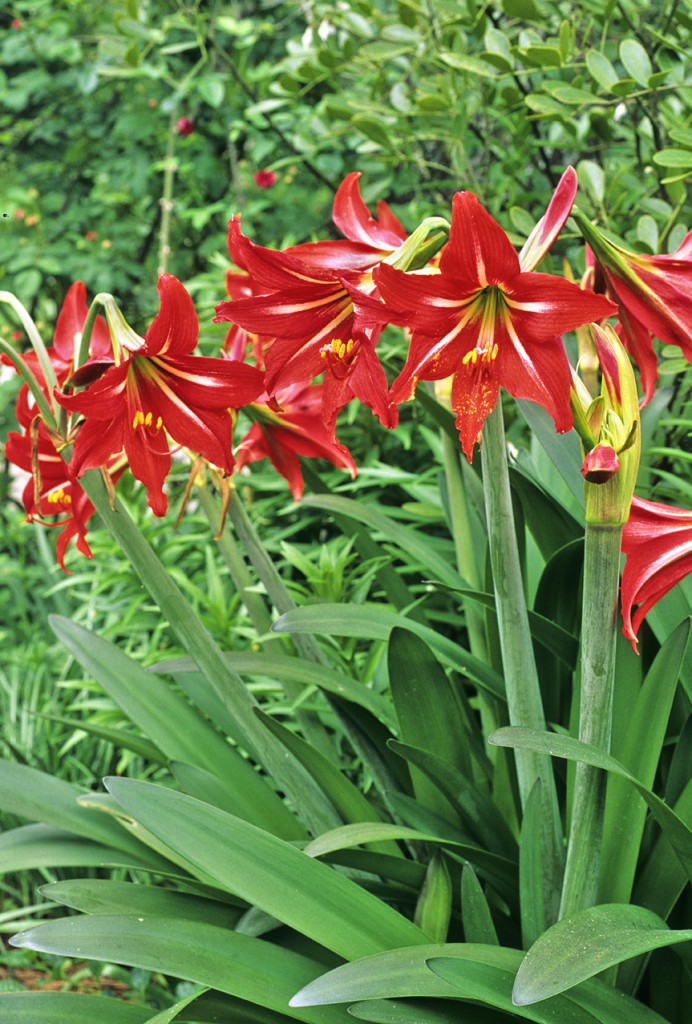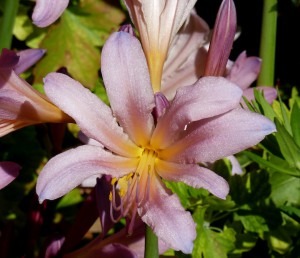
Amaryllis can be regal and extremely colorful.(Photo by Charles Mann)
Scientific Name: Hippeastrum species
Common Name: Amaryllis
Plant Family: Amaryllis (Amaryllidaceae)
Article by Janice Tucker
Even though the starkness of winter has its own style of natural beauty, it does not take long for flower lovers to experience withdrawal symptoms. Hearts rejoice when the seasonal indoor flowers of fall and winter first appear in the shops, nurseries and plant catalogs. Amaryllis bulbs of the Hippeastrum genus with over 90 species and 600 + cultivars are among the most dazzling of these plants.
The Hippeastrum genus, commonly known as Amaryllis, is native to the warm, tropical and subtropical regions of South America and the Caribbean. The Amaryllis genus is native to South Africa. There are about 75 genera and 1600 species in the Amaryllidaceae plant family. To avoid confusion, the use of Amaryllis without italics in this article indicates a common name.
The Hippeastrum bulbs range in size from 2 to 5 inches in diameter. Each bulb will put out slender leaves up to 7 inches long. Depending on the species, 2 to 15 large flowers bloom at the terminus of each tall, hollow stem. Six tepals (3 outer sepals and 3 inner petals) make up the flower composition. Cultivars come in an array of colors including pink, white, salmon, orange, rose and bi-colors but red seems to be the most favored color of the Hippeastrum selections. Some cultivars have “double” flowers, which add to the volume of the cluster at the top of the stem. Species of the Hippeastrum are food sources for some butterflies and moths.
When selecting bulbs, think firm and large. Be sure that there are no signs of softening, bruising, mold or rot. The container should be deep enough to allow for root development and should have enough space for good drainage. Since the Amaryllis actually prefers cramped quarters, the pot needs to be only slightly larger than the bulb, allowing about one inch of soil between the bulb and the edge of the pot. Use a good draining plant medium high in organic matter. Plant the neck and about 1/3 of the bulb so that they protrude above the soil. Make sure the soil is pressed around the lower portion of the bulb to keep it anchored and upright. Water well around the bulb, but always be careful to keep water from going directly into the neck of the bulb. Place in a sunny location. When new growth appears (not before), it is safe to add a fertilizer that is high in phosphorus. The Amaryllis should be moved from direct sunlight when the first tinge of flower color is noticeable. Water when the soil is dry. It is a good idea to stake the stems so they will remain upright when the heavy flowers are in full bloom. For more details, on caring for the plant after flowering, there are many websites with helpful information.
Other genera in the Amaryllidaceae plant family will add beauty to the outdoor landscape. One such plant, the Lycoris squamigera, was featured as a SFBG plant of the month in September 2010. Another favorite is the Amaryllis belladonna. These are beautiful summer-flowering plants and well worth the effort for any gardener.
Taxonomists can attest to controversy and confusion that surround the name of “Amaryllis”, both as a common and a scientific name. Suffice it to say that those of us who love the plant will leave the battle of which genus has the right to the use of the name – botanical or common – to that segment of science and just enjoy its beauty. Simply put, the use of Amaryllis as a genus is assigned to bulbs from South Africa that are usually grown in outdoor gardens. The common name of Amaryllis normally refers to the species and cultivars of the flowering bulbs in the Hippeastrum genus – the type we see in catalogs and stores during the holidays. However, Amaryllis as a common name seems to have spilled over to other genera in the Amaryllidaceae family.

White Amaryllis (Hippeastrum sp.) growing period by Janice Tucker
Need a winter project for the kids? Bulbs are a great way to encourage young plant lovers as they observe the evolution from bulb to flower. The Hippeastrum (Amaryllis) bulbs are readily available and easy to grow indoors during the colder months.
Growing a potted Amaryllis during the holidays is like receiving a gift from Mother Nature that slowly unwraps itself beginning with the first green sprout and capping it off with the full glory of large, colorful, multiple flowers.

Amaryllis can be regal and extremely colorful. Photo by Charles Mann.



